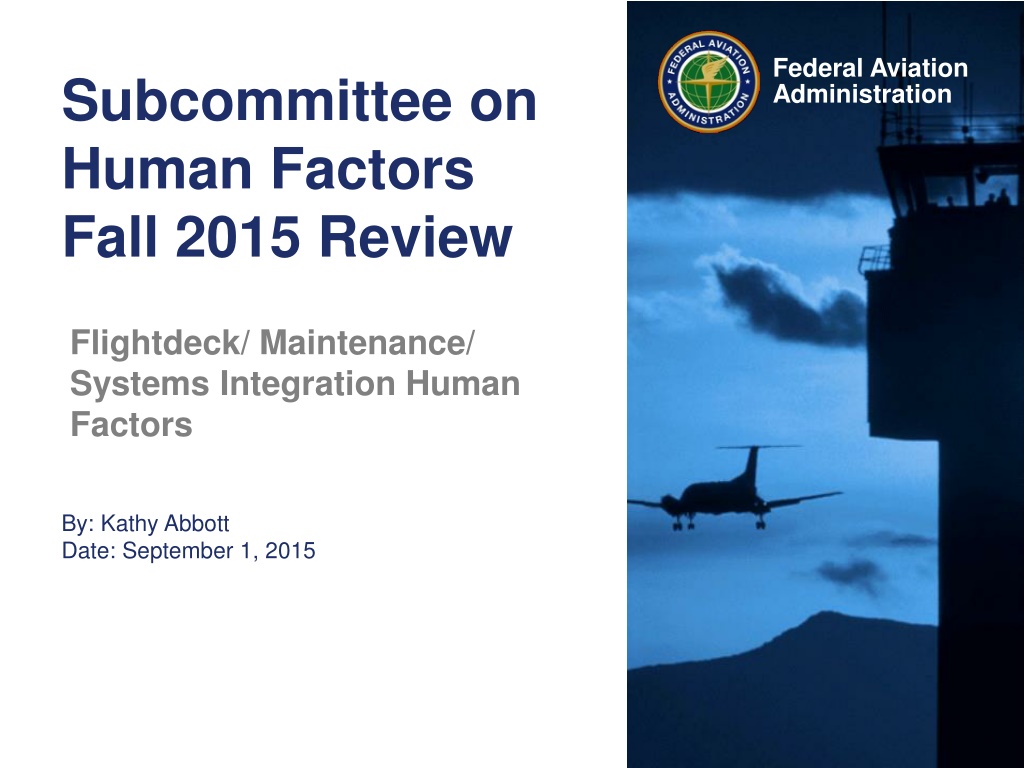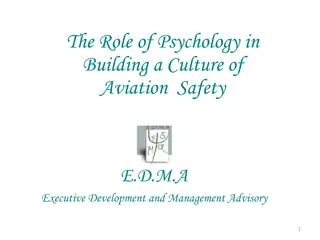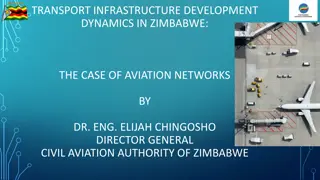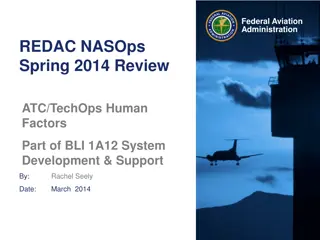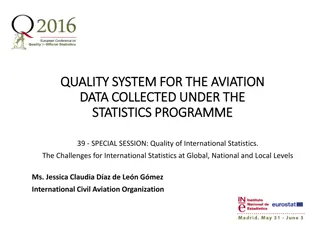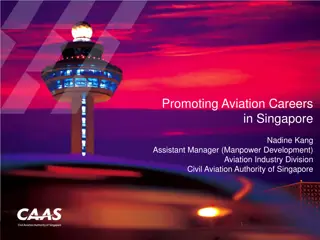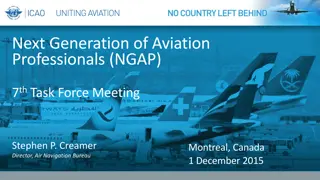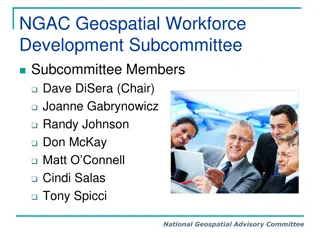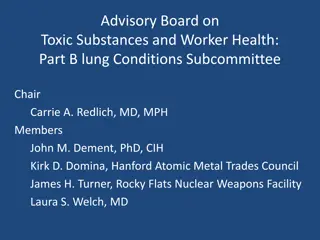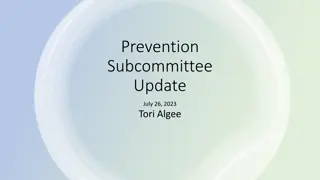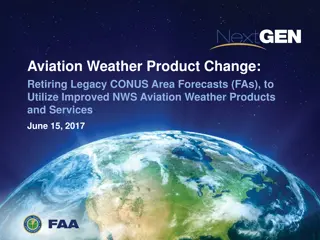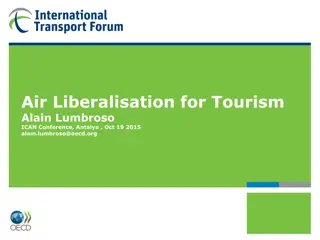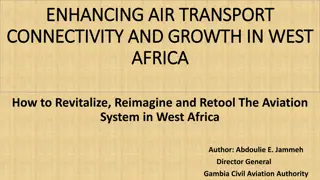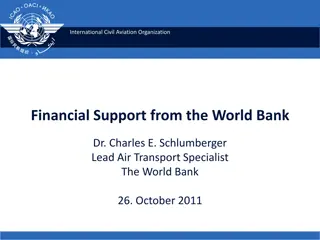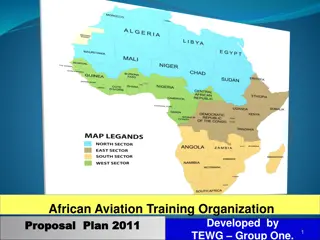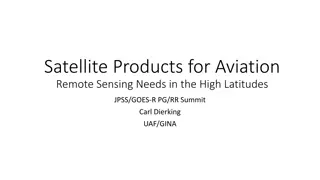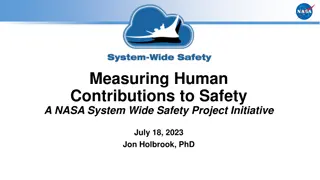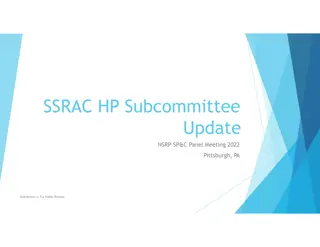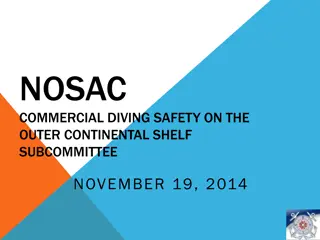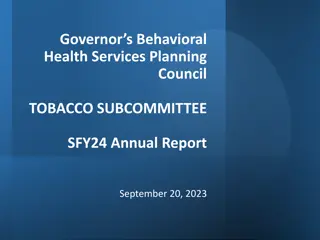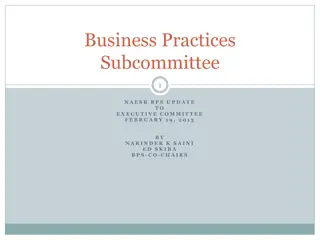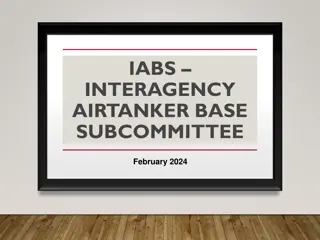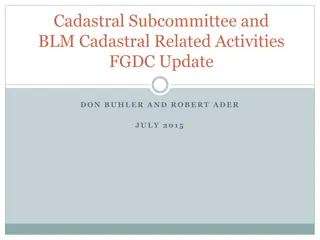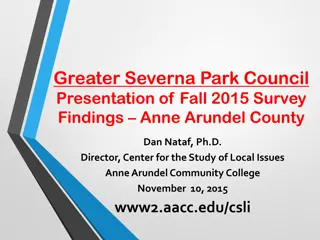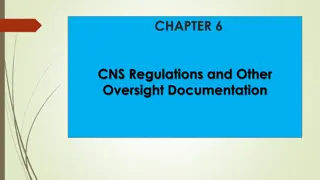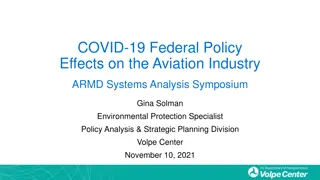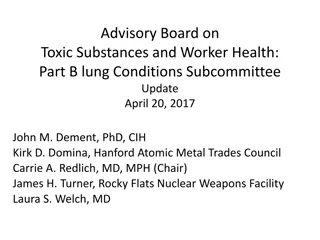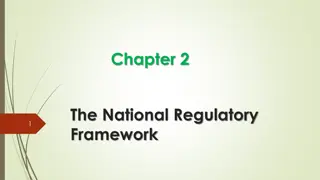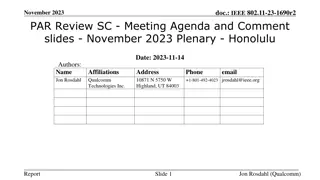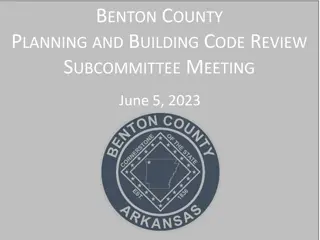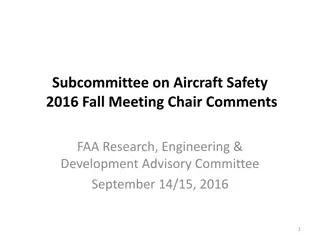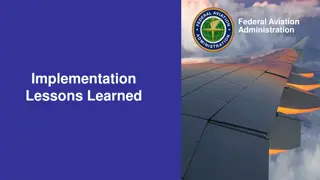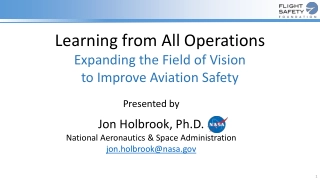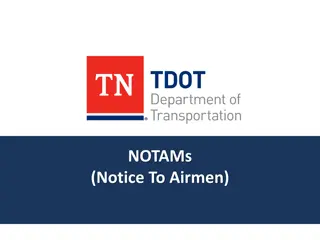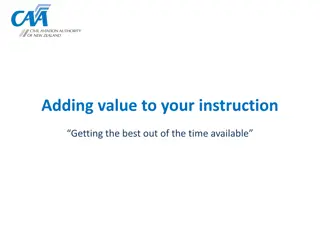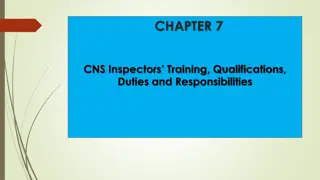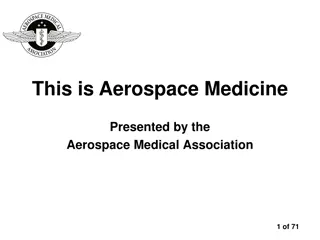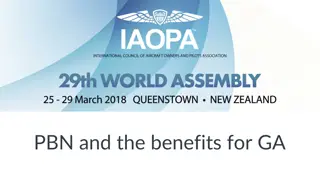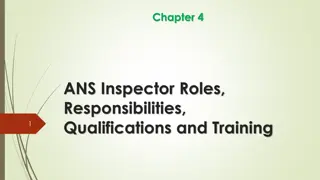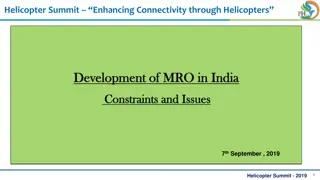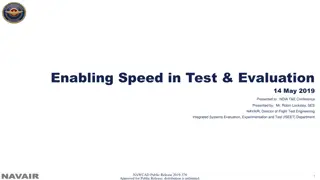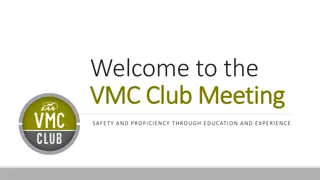Federal Aviation Administration Subcommittee on Human Factors Fall 2015 Review
This document discusses the review of flight deck and maintenance systems integration human factors by Kathy Abbott in September 2015. It outlines the purpose, benefits, and success factors of the BLI Portfolio Overview related to human factors in aviation operations. Furthermore, it presents core flight deck research requirements prioritization from FY14 to FY17, focusing on enhancing aviation safety through advanced procedures, training, and checking methods. Specific research areas like fatigue mitigation in flight operations and loss of control detection, avoidance, and recovery are also highlighted. The document emphasizes reducing risks associated with human performance for ensuring safety in aviation activities.
Download Presentation

Please find below an Image/Link to download the presentation.
The content on the website is provided AS IS for your information and personal use only. It may not be sold, licensed, or shared on other websites without obtaining consent from the author. Download presentation by click this link. If you encounter any issues during the download, it is possible that the publisher has removed the file from their server.
E N D
Presentation Transcript
Federal Aviation Administration Subcommittee on Human Factors Fall 2015 Review Flightdeck/ Maintenance/ Systems Integration Human Factors By: Kathy Abbott Date: September 1, 2015
BLI Portfolio Overview Purpose: Provide data to support evaluation criteria and methods, regulatory material, and recommended practices related to human factors for flight deck systems and applications/functions, flightcrew procedures, training, and operational use. Establish data to support risk management programs to address hazards in the maintenance environment. Benefits: To reduce risks associated with human performance while ensuring safety in aviation operations and maintenance activities. Success:Results of research support development of standards, procedures, training, policy and other regulatory and guidance material as well as human factors assessments of technologies and procedures. Federal Aviation Administration 2
FY14-FY17 Core Flight Deck Research Requirements Prioritization FY 2014 FY 2015 FY 2016 FY 2017 Enhancing Aviation Safety Through Advanced Procedures, Training & Checking Methods, to include Jet Upset Human Factors Maintenance Risk Management FY17 - Maintenance Human Factors to Support Risk-Based Decision Making (RBDM) and Maintenance Safety Culture Avionics & New Technologies: Certification and Operational Approval Criteria Advanced Vision Systems (EFVS, EVS, SVS, and CVS), Head Up Displays (HUD), Head Mounted Displays (HMD): Certification and Operational Approval Criteria General Aviation Safety Improvement Research A Multi-Method Approach to Accident Reduction Human Factors R&D for Improved Rotorcraft Operational Safety Unmanned Aircraft Systems (UAS) Human Factors Considerations Federal Aviation Administration 3 Fatigue Mitigation in Flight Operations
Enhancing Aviation Safety Through Advanced Procedures, Training & Checking Methods, to include Loss of Control Detection, Avoidance, and Recovery (A11G.HF.1) ResearchRequirement Description Pilots are insufficiently trained for flight path management, including loss of control. Research areas include: - Mitigations for startle, surprise, and distraction for loss of control - Crew Resource Management - Alternative paths to Airline Transport Pilot - Design and use of angle of attack indicators (AOA) on integrated displays - Distance learning - Flight path management Sponsor: Rob Burke & Doug Farrow (AFS-280), Kathy Abbott (AVS), Dave Sizoo (ACE-110) Sponsor Outcome Reduction in loss of control inflight accidents. Reduced accidents and serious incidents due to lack of knowledge and skills for manual flight operations. Updates to guidance for CRM training Identification of effectiveness and appropriateness of distance learning. Guidance for the degree to which training can supplant experience and to what degree. Critical Milestones Research Accomplishments in FY15 Jet upset detection and recovery - Recommendations for mitigating startle, surprise, and distraction (FY15) - Evaluation of AoA indicators for general aviation aircraft (FY16) CRM - Data to support CRM training & checking guidance (FY15) - Recommendations for CRM training and checking (FY16) Alternative paths to ATP - Pilot mentoring & selection criteria (FY15) - Identification of performance metrics for evaluating training program effectiveness (FY16) Final technical report for mitigating startle, surprise, and distraction Literature review completed on integrated AOA indicator Technical report on advances in CRM approaches Technical report on pilot mentoring and best practices Draft report on selection criteria for performance based ATP Federal Aviation Administration 4 FY15 HF REDAC Fall Meeting
Avionics & New Technologies (A11G.HF.2) ResearchRequirement Description Sponsor Outcome FAA needs development and update of human factors regulatory and guidance material on evolving flight deck technologies including Automatic Dependent Surveillance Broadcast (ADS-B), Electronic Flight Bag (EFB), cockpit display of traffic information (CDTI), and moving maps Develop and update regulatory and guidance material (i.e., specific rules, ACs, TSOs, Handbooks, etc.) for specific systems (e.g., ADS-B, Electronic Flight Bags (EFBs), moving maps) and documents that provide more general guidance for all flight deck displays (e.g., AC 25-11, AC 23.1311) Focus is on human factors/pilot interface issues such as colors, symbols, fonts, labels, workload, situation awareness, errors, etc. as technology changes Sponsor: Cathy Swider (AIR-134) Research Accomplishments in FY15 Critical Milestones Airport moving map/ADS-B/CDTI, EFBs: - Recommended symbol set (FY16) - Airport moving maps/CDTI industry product review (FY16) - Examine impact of display compellingness and potential mitigations (FY17) General Guidance document - Update to Human Factors Considerations in the Design and Evaluation of Flight Deck Displays and Controls (FY16) - Evaluation guide (FY16) Draft study methodology including design and the creation of an online symbol survey for research moving map and ADSB/CDTI study Draft report of industry product review for Electronic Flight Bags/Portable Electronic Devices (EFBs/PEDs) Created a test version interactive website for the General Guidance document Federal Aviation Administration 5 FY15 HF Fall Meeting
Human Factors Maintenance Risk Management (A11G.HF.3) Research Requirement Description Sponsor Outcome Develop guidance material for inspectors and maintenance organizations Respond to open NTSB recommendations: A-13-001 Establish duty-time regulations for maintenance personnel working under 14 Code of Federal Regulations Parts 121, 135, 145, and 91 Subpart K that take into consideration factors such as start time, workload, shift changes, circadian rhythms, adequate rest time, and other factors shown by recent research, scientific evidence, and current industry experience to affect maintenance crew alertness. (Supersedes Safety Recommendation A-97-71 and is classified Open Unacceptable Response ) A-15-016 Include specific guidance in the Federal Aviation Administration inspector handbook that defines responsibilities for principal inspectors for the oversight of an operator s loading, restraint, and documentation of special cargo loads. Maintenance and inspection errors are significant contributors to both general aviation and commercial aviation accidents. Research areas include: - Maintenance Line Operations Safety Audits - Maintenance Fatigue Risk Management - Failure to Follow Maintenance Procedures Sponsor: Tim Shaver, Acting Division Manager (AFS- 300), Dr. Bill Johnson (AVS) Critical Milestones Research Accomplishments in FY15 Implement field testing of LOSA techniques with at least two major carrier/maintenance organizations (FY15) Field test alternative Maintenance Fatigue Risk Management techniques with at least one major carrier/mx organization (FY15) Review the FAA approval criteria and process for technical documentation. (FY15) Review industry segments policies and practices across the life cycle of technical documentation (i.e., develop, evaluate, revise, approve, deliver, sustain) (FY15) Report on best practices for Maintenance and Ramp Line Operations Safety Assessment (LOSA) Data collection from five carriers currently using Maintenance Fatigue Risk Management systems Technical report on literature review for failure to follow maintenance procedures to develop taxonomy for analysis and solution development Federal Aviation Administration 6 FY15 HF REDAC Fall Meeting
Advanced Vision Systems EFVS, EVS, SVS, and CVS, HUD, HMD Ops Approval Criteria (A11G. HF.4) Research Requirement Description Sponsor Outcome Increase safety, efficiency, capacity, and throughput during low visibility conditions using advanced vision systems, head-up displays, and head-mounted displays. Enable more flight operations to occur in low visibility conditions with less ground infrastructure while maintaining an appropriate level of safety during approach, landing, taxi, and takeoff operations. Human factors data to support operational credit and approvals is needed for: - New applications with synthetic vision displayed on the head up display (HUD) - Synthetic vision and guidance information for civil applications of head-worn displays - Use of head-worn displays Sponsor: Terry King (AFS-400) Research Accomplishments in FY15 Report on display formats HUD or HDD for SA CAT I approach with varied RVR and DH delivered to sponsors Critical Milestones HMD/HUD (head mounted display/ head up display) - Simulation to quantify performance contribution of HUD use (FY16) - Industry/product review of existing HMD systems (FY16) - Research plan and data collection identifying human performance considerations (FY17) SVGS - SVS simulation measuring baseline performance (FY16) - Characterize pilot performance using SVGS for specific low visibility operations (FY17) - Identification of minimum training and currency requirements for SVS proficiency (FY18) Federal Aviation Administration 7 FY15 HF REDAC Fall Meeting
General Aviation Safety Improvements Research A Multi-Method Approach to Accident Reduction (A11G. HF.6) Research Requirement Description Sponsor Outcome Identify and evaluate appropriate interventions for reducing the GA accident rate through research focused on: 1) Available aircraft equipment/technologies not currently used in GA and 2) New ways of addressing errors in pilot decision making. Sponsor: Dave Sizoo (ACE-110) Update regulatory and guidance material, e.g., AC 23.1311-1C and AC 23-17C, plus policy for 23.1329 which provide more general guidance for the relevant flight deck displays Critical Milestones Research Accomplishments in FY15 Developed add-on AoA simulation environment for data collection Research plan for simulator evaluation Collecting data on add-on AoA in simulator Research plan and data collection for simulator evaluations of each AoA indicator (FY15) Human factors data and research recommendations identifying: (1) underlying causes of loss of control and stall in GA, and (2) potential intervention points (FY16) Federal Aviation Administration 8 FY15 HF REDAC Fall Meeting
Human Factors Research and Development for Improved Rotorcraft Operational Safety (A11G. HF.7) Research Requirement Description Sponsor Outcome A number of operational and technology challenges for the rotorcraft community may impact operational safety. Three Initiatives are prioritized from high to low as shown below: - Helicopter Training Devices - Scenario Based Training (SBT) for parts 61, 91, 141, and 135 operations - Helicopter Crew Resource Management (CRM) for Part 91 and 135 operators including HAA operators. Sponsor: Steve Sparks (AFS-810) Improve safety of IFR operations in high density helicopter operations areas Separate IFR operations from other commercial operations in metroplex areas. Update guidance for aviation safety inspectors on oversight of 135 HEMS operators and weather decision making in operator training programs (FSIMS Order 8900.1). Potential update to AC 120-51 for CRM training for HEMS operations. Critical Milestones Research Accomplishments in FY15 Document current literature related to: (FY16) - Helicopter Training Devices - Scenario Based Training (SBT) for parts 61, 91, 141, and 135 Operations - Helicopter Crew Resource Management (CRM) for Part 91 and 135 operators including HAA operators. Develop research plan to address knowledge gaps (FY17) Data collection and recommendations (FY18) Note: In FY15, this project was performed with internal staff resources only. No contract funds were programmed. Initiated literature review on helicopter training devices, simulator based training, and helicopter CRM Federal Aviation Administration 9 FY15 HF REDAC Fall Meeting
UAS Human Factors Control Station Design Standards (A11L.UAS.1530) ResearchRequirement Description Sponsor Outcome Function allocation strategy for civil UAS Minimum standards and guidelines for civil UAS control stations Recommended crewmember training and certification requirements for civil UAS operations Recommended visual observer training and certification requirements for civil UAS operations Sponsor: Stephen Plishka (AFS-86) Research will provide input to FAA standards and Advisory Circular material to support the safe, efficient, and timely integration of UAS into the NAS. Performing sound research will lead to preventative measures in reducing incident and accident rates due to human factors in civil UAS operations, as well as may translate to reduced rates in public UAS operations. Critical Milestones Review of relevant research studies (FY16) Analyses of UAS human factors related incidents and accidents (FY16) Gap analysis between current flight deck/control station and crewmember regulations, standards, and guidance (FY16) Development of control station standards and guidelines (FY18) Development of recommended crewmember training and certification requirements (FY18) Development of recommended crewmember procedures and operational requirements during normal and non- normal events.(FY18) Research Accomplishments in FY15 Note: This project received funding in June 2015; consequently, program execution just started. Accomplishments to support the program execution are provided below Coordination with ANG-C2 for inclusion in the ASSURE UAS Center of Excellence Program Proposal received from ASSURE UAS Center of Excellence Federal Aviation Administration FY15 Human Factors Fall Meeting
